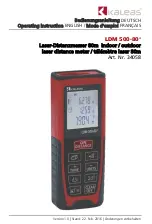
Dryer Master
A
M
3
Product Manual
©
Dryer Master Inc.
Page: 65
7.2.1 Sensor Power requirements
The sensor requires 18 to 30 volts DC at less than 20 mA. Two output signals in the 0 to 10 volt range
provide the temperature and a measure of dielectric properties of the material in the sensor. The
sensor power requirements are low enough to permit locating the sensor in class 2 and class 3
environments using Intrinsic Safety Barrier protection.
7.2.2 Grounding
The sensors require a good ground to function dependably. Run a ground wire from the sensor chassis
ground to the signal-processing Panel. The sensor chassis must be at the same ground potential as the
signal grounds. Large ground potential differences may contribute to erratic operation of the sensor
and possible sensor failure.
7.2.3 Signal Output
The sensor output is 0
–
10 Volts, 2 signals, dielectric (moisture) and product temperature. Minimum
recommended load resistance is 10k ohm for each output. The outputs are protected from shorts to
ground and supply. The output signal is a voltage to permit locating the sensor in class 2 and class 3
environments using Intrinsic Safety Barrier protection.
7.2.4 Sensor Not Reading Empty with no product present
In order for the sensor to operate properly it must show “Empty” when no product is present in the
chute. If the sensor does not show empty either the Empty you will need to take the following
corrective measures:
1)
Check the Empty voltage settings
. This value is typically 0.9 volts and is found at “Engineering
Functions 3
–
Slope, Offset entry”
2)
If this setting is correct, check the voltage
at “Engi
neering Functions 6
–
Input voltage
diagnostics display”.
a)
If the value is greater than 0.9 volts either the distance between the sensor and the
display unit is too large for the wire size used
b)
There is a ground potential difference which is interfering with the operation
c)
There is potentially high energy electrical noise radiating into the signal wiring.
To correct this do the following:
1)
Join the “Black” signal & power lead in the moisture senor enclosure to the earth ground lead.
Leave the existing connections in tack. This in effect grounds the Moisture sensor electronics to
the case and also grounds the display to the moisture sensor. In 90% of the cases the problem
will be eliminated.
2)
If the issue is due to the distance between the sensor and the display
a)
Try doubling up on the black signal return lead. Use the shield as an additional
conductor to bring the signal down.
b)
Increase the sensor Empty voltage setting.
7.3 Sensor setup & diagnostics
Note: The sensor has been prepared to operate within the specification range of the product. The Sensor setup &
diagnostics sheet serves as a diagnostics tool to verify the sensors operation and functionality and provide
electrical connection locations. There is no need to calibrate a new sensor. It is permissible to note the signals by
stepping through the calibration procedure. This will provide a base for comparison should the sensors function
come into question at some time in the future. Adjusting the hardware calibration will negate the software
calibration adjustments that have taken place over time. Hardware recalibration should only be attempted if the
sensor no longer functions. There are no end user replaceable components in the sensor. If the sensor fails or
cannot be setup as described on the diagnostics sheet it can be returned to Dryer Master for service. Contact
Dryer Master for additional information.
Summary of Contents for AM3
Page 1: ......
Page 84: ...Dryer Master AM3 Product Manual Dryer Master Inc Page 82 11 Appendix C IMO Set up Guide ...
Page 85: ...Dryer Master AM3 Product Manual Dryer Master Inc Page 83 ...
Page 86: ...Dryer Master AM3 Product Manual Dryer Master Inc Page 84 ...
Page 87: ...Dryer Master AM3 Product Manual Dryer Master Inc Page 85 ...
Page 88: ...Dryer Master AM3 Product Manual Dryer Master Inc Page 86 ...
















































